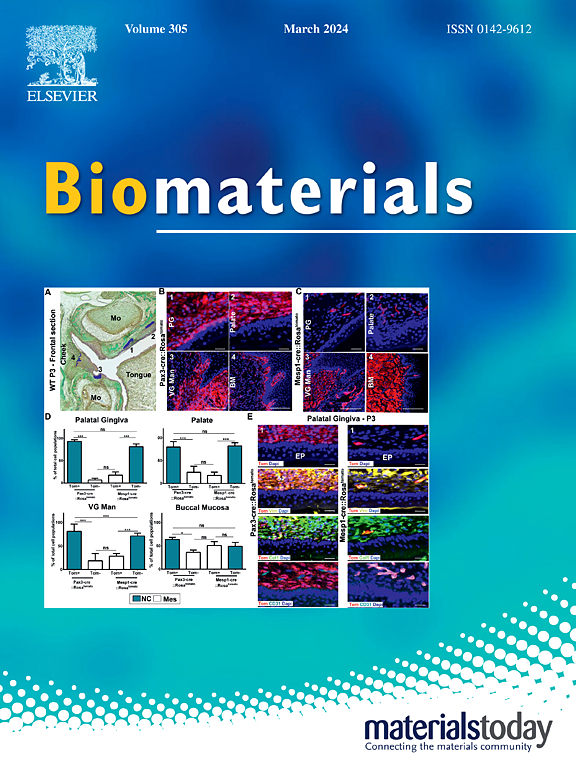NIR-activated nanodisguisers for targeted bactericidal action and enhanced electron transfer in periodontitis treatment
IF 12.8
1区 医学
Q1 ENGINEERING, BIOMEDICAL
引用次数: 0
Abstract
Antibacterial treatment for periodontitis faces significant challenges due to the lack of selective bactericidal therapies. In this study, we developed multifunctional nanospheres encapsulated with Fusobacterium nucleatum-derived outer membrane vesicles (OMVs) to target periodontal pathogens specifically. These OMVs act as a "camouflage," allowing the nanospheres to infiltrate bacterial environments undetected, adhere to pathogen surfaces, and maximize therapeutic effects. Direct contact between nanospheres and bacteria accelerates electron transfer, and nanospheres trigger a proliferation of endogenous reactive oxygen species (ROS), leading to oxidative stress and bacterial death. Transcriptomic analysis confirmed that the nanospheres accelerated electron transfer activity and disrupted deoxyribonucleic acid (DNA) repair mechanisms and thiamine metabolism while enhancing bacterial respiration. Though supported by dual photodynamic and photothermal therapies under near-infrared light, the primary mechanism of action focuses on electron transfer and metabolic disruption. In vitro and in vivo experiments demonstrated the nanospheres’ potent biofilm eradication and periodontitis treatment efficacy, offering a promising new approach for selective bacterial targeting. This strategy targets pathogens effectively and preserves the beneficial microbiota, providing an innovative solution for treating periodontitis and other biofilm-related infections.
nir激活的纳米伪装剂在牙周炎治疗中的靶向杀菌作用和增强电子转移
由于缺乏选择性杀菌治疗,牙周炎的抗菌治疗面临重大挑战。在这项研究中,我们开发了多功能纳米球包被梭杆菌核源外膜囊泡(OMVs)特异性靶向牙周病原体。这些omv作为一种“伪装”,允许纳米球渗透细菌环境而不被发现,附着在病原体表面,并最大化治疗效果。纳米球与细菌的直接接触加速了电子转移,纳米球引发内源性活性氧(ROS)的增殖,导致氧化应激和细菌死亡。转录组学分析证实,纳米球加速了电子转移活性,破坏了脱氧核糖核酸(DNA)修复机制和硫胺素代谢,同时增强了细菌呼吸。虽然有近红外光下的双光动力和光热治疗支持,但主要的作用机制集中在电子转移和代谢破坏上。体外和体内实验证明了纳米微球有效的生物膜根除和牙周炎治疗效果,为选择性细菌靶向治疗提供了一种有希望的新方法。该策略有效地靶向病原体并保留有益微生物群,为治疗牙周炎和其他生物膜相关感染提供了创新的解决方案。
本文章由计算机程序翻译,如有差异,请以英文原文为准。
求助全文
约1分钟内获得全文
求助全文
来源期刊

Biomaterials
工程技术-材料科学:生物材料
CiteScore
26.00
自引率
2.90%
发文量
565
审稿时长
46 days
期刊介绍:
Biomaterials is an international journal covering the science and clinical application of biomaterials. A biomaterial is now defined as a substance that has been engineered to take a form which, alone or as part of a complex system, is used to direct, by control of interactions with components of living systems, the course of any therapeutic or diagnostic procedure. It is the aim of the journal to provide a peer-reviewed forum for the publication of original papers and authoritative review and opinion papers dealing with the most important issues facing the use of biomaterials in clinical practice. The scope of the journal covers the wide range of physical, biological and chemical sciences that underpin the design of biomaterials and the clinical disciplines in which they are used. These sciences include polymer synthesis and characterization, drug and gene vector design, the biology of the host response, immunology and toxicology and self assembly at the nanoscale. Clinical applications include the therapies of medical technology and regenerative medicine in all clinical disciplines, and diagnostic systems that reply on innovative contrast and sensing agents. The journal is relevant to areas such as cancer diagnosis and therapy, implantable devices, drug delivery systems, gene vectors, bionanotechnology and tissue engineering.
 求助内容:
求助内容: 应助结果提醒方式:
应助结果提醒方式:


